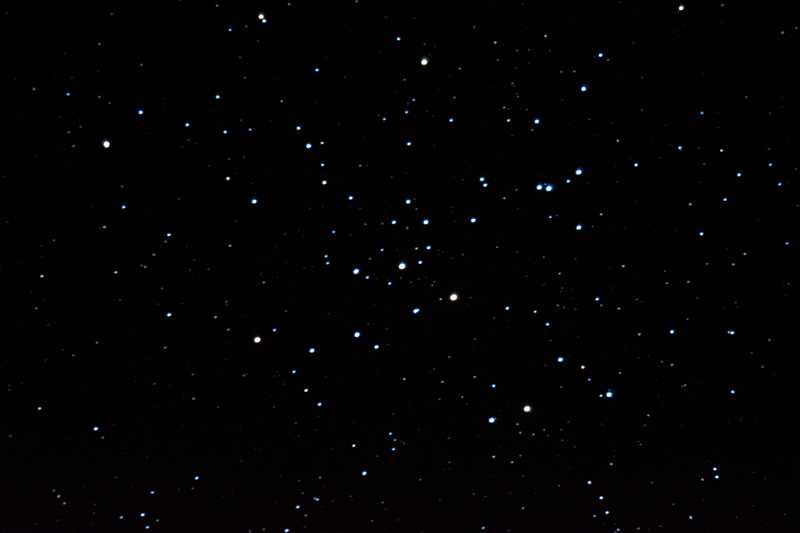More PZT work;
More DSLR DSO Astrophotography Tests
Posted: 9 March 2016
Tuesday morning, 1 March 2016, the wife and I did some yard work. The main task was removing a packrat nest near the observatory. Clouds increased while we were working, with the sky becoming overcast by mid-afternoon. Cloudy skies continued on Wednesday, 2 March. I did some more construction work for the POD Zenith Table (PZT), making the underside support braces:

Now waiting for the PZT Hardware Kit to arrive from Canada.
Clouds continued on Thursday, 3 March. That night I attended a meeting of the Oracle Dark Skies Committee (ODSC). A main topic of discussion was final planning for the Star Party at Oracle State Park on Saturday, 5 March. Cloudy skies continued on Friday.
On Saturday, prior to the Star Party I conducted a "Beginner Digital Astrophotography" workshop at the Park. I held the same workshop last October, but "play time" with some telescopes was clouded out that night. We decided to have it again prior to this Star Party and hoped for clear skies for a "play time". Well, the Workshop was well attended and even the Star Party had a good turnout, cloudy skies limited the night sky viewing. A report on the events at the Park is on the ODSC web site.
Sunday evening, 6 March, was partly cloudy but with strong winds blowing. Didn't open the observatory. Monday was overcast, with 0.05" rain early Tuesday morning. As sunset approached on Tuesday, 8 March, the sky finally began clearing.
|
Open: Tuesday, 8 March 2016, 1813 MST Temperature: 70°F |
Session: 931 Conditions: Clear |
First, synced the observatory clock to WWV. 1826 MST: sunset. 1829 MST: the star Sirius was faintly visible against the bright sky in the south.
Since I planned to do some Wi-Fi tests I used the wired AutoStar II handcontroller as the Wireless AutoStar II interferes with Wi-Fi on the LX600. 1833 MST: powered on the 12" LX600 telescope and initially let the StarLock do its thing. However, the sky was still too bright and the StarLock couldn't lock onto Sirius for autocentering. I aborted the GOTO and turned StarLock OFF. The AutoStar GOTO put Sirius near the field-of-view (FOV) center in the 2" 24mm UWA eyepiece (102X).
1837 MST: powered on the GC Wi-Fi Adapter for some tests of a new development release of ScopeBoss. 1906 MST: ended ScopeBoss tests.
Jupiter, at opposition this night, had just risen over the hill to the east. Viewed it, 102X, but it was too low for good seeing. Four moons were visible.
1913 MST: viewed M41 (open cluster) in Canis Major, 102X. Pretty view. I then began preparing for DSLR imaging. But first, made a trip to the house for a warmer coat. 1924 MST: turned StarLock back ON. Did a GOTO Sirius; autocentering worked well this time. Did a focus test using the Astrozap focus mask. I wanted to try some DSO imaging tests even though I have not finished tweaking the StarLock setups (which I don't plan to do until the pier is installed). This is a 30 seconds, ISO 1600, White Balance 4000K, image of M41 taken using the D7200 DSLR at prime focus + Optec focal reducer:

Next, slewed to NGC7635 (Bubble Nebula) in Cassiopeia. This is a 5 minutes, ISO 6400, White Balance 4000K, StarLock guided image (slightly cropped) using the focal reducer:

I still have some more adjustments to make before I'll be getting really good DSLR DSO images with the 12" LX600. One thing I noticed this night was that the focal reducer was a little loose in the visual back with its two screws holding the focal reducer, so the focus might have shifted. Will have to check that in the daytime.
Removed the focal reducer and went back to Sirius for another focus test with the mask. Then took this 10 seconds, ISO 1600, White Balance 4000K, image of M41:

2020 MST: completed imaging tests for this night. Did another quick ScopeBoss test.
2039 MST: turned the StarLock OFF and did a GOTO Jupiter. Seeing was still pretty bad. Turned the StarLock ON and did a GOTO M51 (Whirlpool Galaxy). The galaxy was centered in the 102X eyepiece. Nice view even though the galaxy was still low in the northeastern sky. Some spiral arms structure was visible using averted vision.
The last thing done this night was a collimation "star test" using Sirius with and without the star diagonal. Collimation was good.
Due to a lot of activities planned for the next day, reluctantly ended the session.
|
Close: Tuesday, 8 March 2016, 2113 MST Temperature: 47°F |
Session Length: 3h 00m Conditions: Clear |
Comments are welcome using Email. If you are on Twitter you can use the button below to tweet this report to your followers. Thanks.
Cassiopeia Observatory Home Page
Copyright ©2016 Michael L. Weasner / mweasner@me.com
URL = http://www.weasner.com/co/Reports/2016/03/09/index.html
